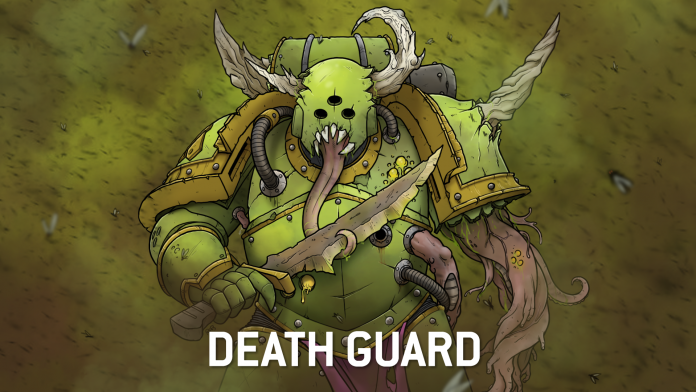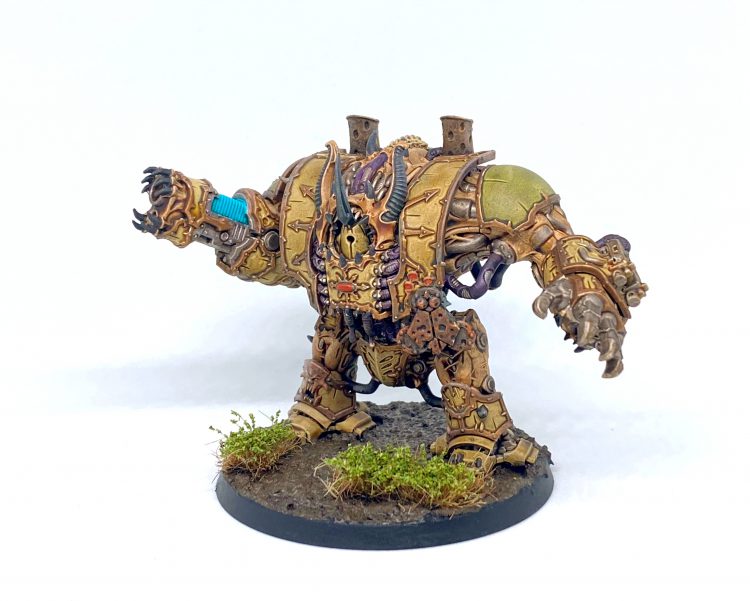In this article series we’re taking a look at the vehicle options available to each faction, looking at what they can do on the table, and talking about when and how to field them. You can find our Competitive Faction Focus article on the Death Guard here.
The Death Guard don’t have the game’s best vehicles by any stretch, but they do have some very solid options, with a lot of really cheap, fast vehicles which can create real problems. With Pariah Nexus making Bring it Down much worse against armies taking lots of vehicles with fewer than 15 wounds. there’s a very real space for a mechanized Death Guard list, and some of those have seen success recently. While Death Guard are traditionally a slow army, it’s very easy and rewarding to build an entire list of units which move 10″ or have Transports, making them surprisingly fast on the table.
The Death Guard monsters and vehicles are presented here in alphabetical order by datasheet name.
Changelog
- Update (Latest): 2024-08-15 for the June 2024 Balance Update
- Update: 2024-02-18 for the Q1 2024 Balance Dataslate
- Published: 2023-12-29
Death Guard Daemon Prince
The Death Guard Daemon Prince is a moderately durable character (T11, 2+/4++ save, 10W) who comes with 7″ Movement and some decent – but not amazing – melee (for some reason they chose not to give him Lethal hits on his attacks, which is a shame). His special ability is the Grandfather’s Blessing (Aura), which gives friendly Death Guard Infantry units within contagion range a 6+ Feel No Pain ability. That Contagion Range rider is fun but ultimately bad since it means the aura only reaches 3″ in the first battle round, when you’d rather it reach further. At only 160 points the Death Guard Daemon Prince is among the cheapest variants of his datasheet but he’s just not worth the points for what he brings to the table.
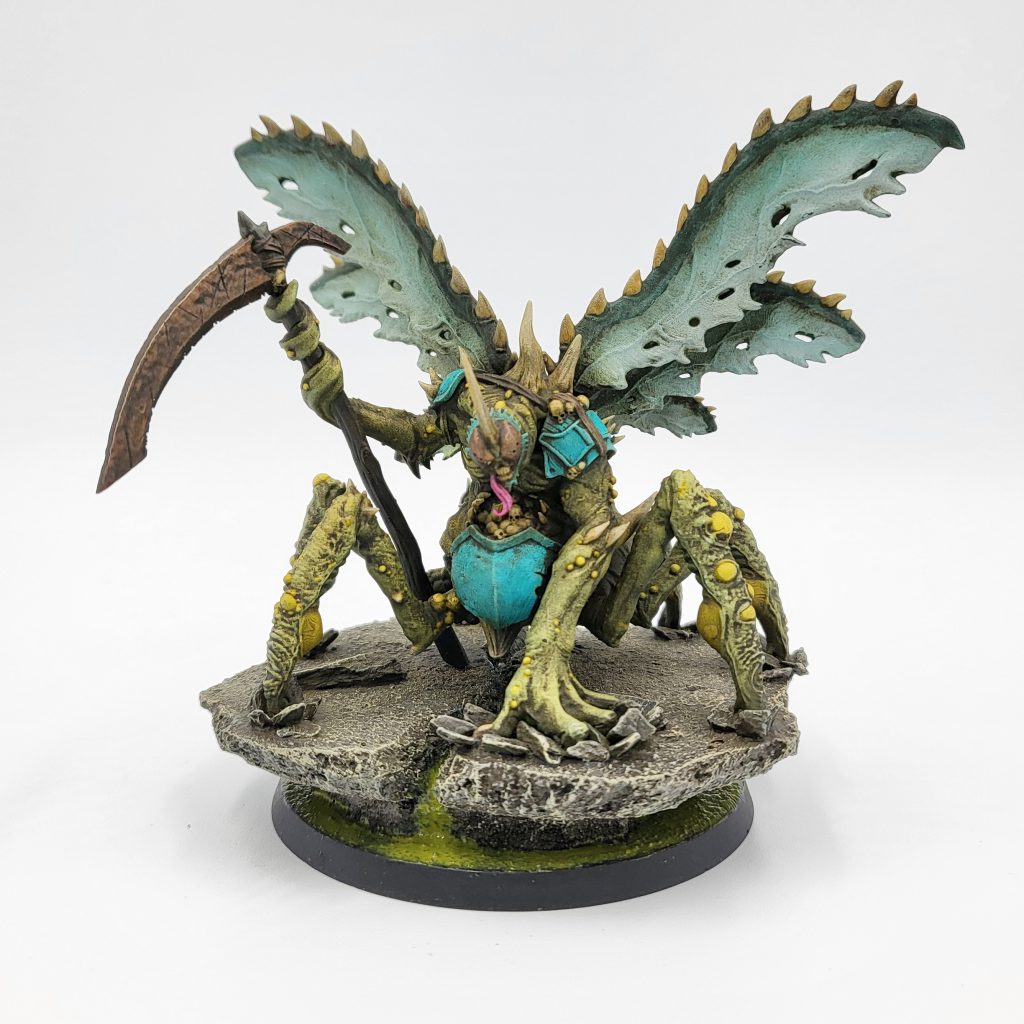
Death Guard Daemon Prince with Wings
The winged variant comes with T10 but an 11″ Movement and FLY, and costs a whopping 35 points extra. he also gives up the Feel No Pain aura for two melee abilities that key off charges, Warp Horror and Devastating Assault. When this Daemon Prince completes a charge move, he causes a battle-shock test to one enemy unit in Engagement range and his hellforged weapons gain Devastating Wounds. These are OK, and the Dev Wounds can be more interesting if you have Mortarion hanging around to give you some re-rolls on the wound rolls, but ultimately you just don’t need melee punching power when your plague marine squads can handle that just fine.
Death Guard Defiler
A walking tank that combines the firepower of a predator with the fighting prowess of a Dreadnought, the Defiler is an interesting unit. The 10th edition incarnation adds Scuttling Walker, which lets it walk over friendly vehicle/monster units and over terrain that’s 4″ or less in height, making it fairly useful for moving around the table despite its size – though with only 8″ movement it’s one of your slower options. The Defiler comes with a Defiler Cannon, which gives you an OK shooting profile with 48″ range, D6+3 Blast shots which hit at S10 and 3 damage… but only AP-1. The Defiler come with a twin lascannon in place of its twin heavy bolter/reaper autocannon, and you’ll pretty much always want to do that to give it as much ranged punch as possible. After that, the havoc launcher is less useful, especially when it means giving up the scourge. In Melee the Defiler has 5 attacks which hit at S16 AP-3 D6+1 damage, which is pretty nasty, but with no re-rolls or WS improvement, you’ll likely find yourself disappointed with that output.
Ultimately the Defiler is just kind of OK. Its cannon doesn’t have the AP to reliably punch through armor, and it doesn’t have enough melee attacks to reliably push through more than one wound against targets with an invulnerable save. On the flip side, in a similar fashion to dreadnoughts the Defiler is costed such that you’re paying for the unit to be mediocre at two things, and so at 190 points is just crazy overcosted for a unit with a 3+/5++ save. If you’re trying to make Defilers work, they can pair very nicely with the Lord of Virulence, who gives their main cannon +1 to hit against targets in his line of sight. Otherwise, play aggressively with it and use it to bully units off objectives and charge wounded targets to finish them off.
Death Guard Helbrute
The Death Guard Helbrute is a relatively standard Chaos Dreadnought in terms of statline – 6″ movement, T9, 2+ save, 8W – but comes with a few extra quirks that make it worth consideration. The first is the Infused with the Blessings of Nurgle ability – each time this model shoots or fights, after it finishes making its attacks, you can pick one enemy unit that was hit by one or more of those attacks, and until your next turn, that unit is always considered to be within Contagion Range of the Dreadnought. This is an ability that flew under the radar before the dataslate but with the addition of new contagion effects gained immediate “build-around-me” implications – your Helbrute can now tag an enemy unit at a distance to reduce its saves by 1 or give it -1 WS/BS for a turn, either tagging it for other units to finish off from outside Contagion range, or reducing its accuracy to protect some key unit. This is, in theory, a really great way to use a unit which can also bring a bit of added melee power to your army.
Unfortunately, in practice, the Helbrute isn’t all that necessary – the dense terrain layouts of the WTC and GW boards means that having lines of sight longer than 24″ isn’t common and the Helbrute isn’t fast enough to move around terrain quickly, nor can it move through walls. What this means is that by the time you’re actually close enough to hit with other units to take advantage of the Helbrute’s ability to give a unit -1 to its saves with Rattlejoint Ague, they’re likely within the 6″ or 9″ range they need to just get the benefit themselves. In terms of dropping -1 WS/BS on a target well, chances are you’ll either just kill the target or your helbrute will be the only thing it could see and it’ll soak up that firepower anyways. And either way, your Helbrute will have the same problems as the rest of the army when it comes to trying to hit something out of line of sight.
So what you’re left with is a unit with a very neat ability which is just kind of mediocre and a little too expensive for what you get – those five fist attacks are going to disappoint you most of the time. If you want to take a Helbrute, it’s not the end of the world – they work best as a one-of. Give them a double lascannon and a fist with a plague combi-bolter in it and use him to tag targets your Plagueburst Crawlers can’t see. Consider putting it in Strategic Reserves as a way to get it across the table sooner, and pair him with a Lord of Virulence for maximum effect.
Death Guard Land Raider
The Death Guard Land Raider offers a tough (T12, 16W, 2+ save) vehicle capable of carrying 12 marines or 6 terminators with a 10″ move and the Assault Ramp rule to let them charge after disembarking. It comes with four lascannons and a twin-linked plague heavy bolter, plus the option for a couple of extra weapons on top. With Terminators who only move 4″, the Death Guard Land Raider seems like a must-have for terminator-heavy lists. That said, it’s done in by both its high cost (240 points) and the fact that Deathshrouds come in units of 3 or 6, meaning you can’t take a larger unit with a character in a Land Raider. On top of that, the Land Raider just doesn’t do anything Death Guard armies need – the Terminators can teleport, your plague marines will go in rhinos, and the lascannons, while neat, are largely covered by the entropy cannons on your Plagueburst Crawlers and multi-meltas on your Blight-Haulers. Death Guard Land Raiders aren’t terrible, but they’re just beaten out by a host of better choices and ways to go to war.
Death Guard Predator Annihilator
If you’re really looking for extra anti-vehicle support, this is the option you typically end up with in the Death Guard list. The Annihilator comes with two lascannons and a twin-linked lascannon and the ability to re-roll damage rolls of 1 against Monster or Vehicle targets. These used to see play in more lists, but since changes to TOWERING and point costs have made Wraithknights and Knights generally less viable they’ve been traded out for smaller vehicles, Destructors, and more infantry. They’re not bad, and can be very solid, mobile options at on the cheap if you’re looking for some real anti-vehicle punch.
Death Guard Predator Destructor
The more infantry-focused variant of the Predator, the Destructor trades out its twin lascannon for a 3-damage AP-1 autocannon with Rapid Fire 2 which gets +1 AP when firing at Infantry units. When you combine that with the Rattlejoint Ague contagion to get what’s functionally AP-3 against heavier targets that’s massive, and that will let you hit even Terminator targets in cover on their invulnerable saves, with a dead model per failed save. The Destructor’s speed also makes it easy to close some of those distances, allowing you to get into rapid fire range pretty reliably. The Predator Destructor tends to fill the same role in the army as a War Dog Brigand, but cheaper and with better Stratagem support, but it’s not out of the question to see both in lists that go super-heavy on vehicles. Put lascannons on the sponsons and load it up with extra weapon options.
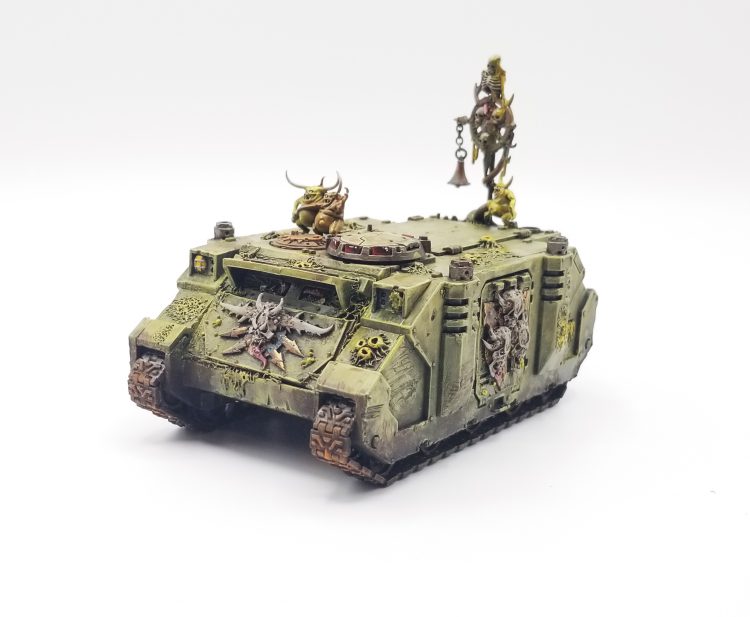
Death Guard Rhino
There isn’t much to say about Death Guard Rhinos in particular – they’re amazing transports and well worth their 75-point cost. They significantly improve the mobility and durability of your plague marines while acting as amazing decoys and move blockers once they’ve been emptied out. Current meta lists now run upward of the maximum number Rhinos, sporting 5-6 in lists that run very heavy on Plague Marines. If you’re running Plague Marines, you basically want a Rhino to carry them around. In addition to significantly boosting their movement, you need Rhinos to protect your relatively fragile marines from indirect firepower like Nightspinners, Exorcists, Whirlwinds, and Plagueburst Crawlers. Each of these multi-damage units will ruin your units’ days and if you don’t want to put your models in Strategic Reserves, a Rhino is your best alternative.
Generally speaking, you want keep your Plague Marines inside their transport until they absolutely need to exit, either to take out some target, because you are being threatened by a unit who might charge and wrap your transport (and especially if you want to overwatch them), or because you need to split up. Leaving the unit inside keeps them safe and turns the transport into a kind of hateful piñata – an opponent killing one on an objective will suddenly find the objective much harder to take as it now has more bodies and OC on it. Even after your Plague Marines get out, the Rhino still acts as a wonderful, semi-durable, fast unit which can range around the table doing actions, blocking movement, and scoring VP.
Rhinos are great and if you’re taking Plague Marines you want enough Rhinos to fit all of them. Load them up with Havoc Launchers and Combi-bolters and plague bolters and remember to use them for the occasional extra pot shot to chip away at enemy health. Once their passengers disembark, use them to bully opponents, either contesting objectives, charging units that don’t want to be tagged, or running up to project contagion aura on units which otherwise might be out of range.
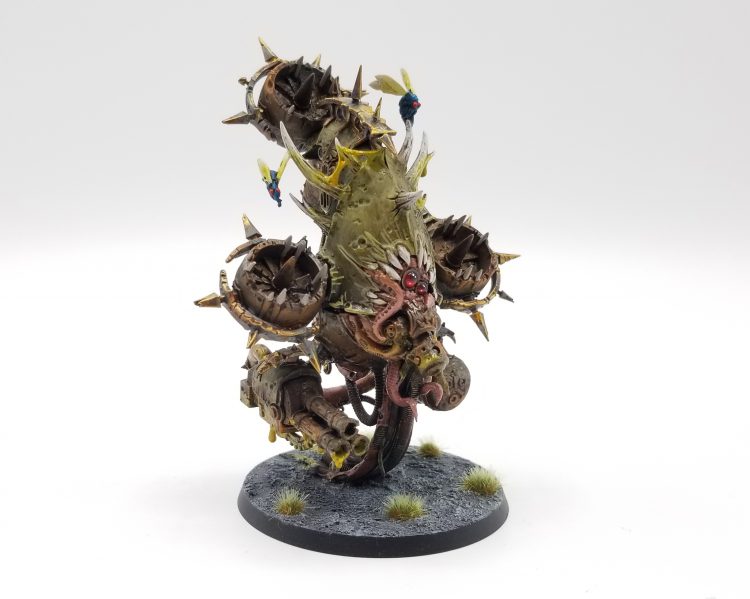
Foetid Bloat-Drone
The Foetid Bloat-Drone is a 10″ Move Flying vehicle with T9, 10W, and a 3+/5++ save. It’s a relatively fast and feisty vehicle that comes with the ability to shoot and charge after Falling Back. These come in three varieties: The Fleshmower is the melee version, giving you 10 attacks at WS3+, S7, AP-1, 2 damage. The Heavy Blight Launcher gives you 6 Lethal Hits shots at S8 AP-2, 2 damage and 36″ range. And the Two Plaguespitters give you 2D6 S6 AP-1 1-damage Ignores Cover / Torrent / Anti-Infantry 2+ shots at 12″ range.
Once a must-take in Death Guard armies, the Bloat-Drone has fallen quite a bit in 10th edition, owing mostly to just having poor AP and only 10 attacks on the Fleshmower. It’s still just scary enough in Fleshmower mode that a lot of opponents will respect it and take it out first if they can, but once it hits combat it’s surprisingly likely to disappoint you, especially now that Terminators and Gravis units are working with T5+. The Heavy Blight launcher is a fun profile, but HBL drones just don’t do enough to justify their costs and having an anti-infantry gun isn’t that much for you.
The real heavy hitter for the Bloat-Drone ends up being the twin plaguespitter variant, whose two Torrent guns are ideal for taking on heavier infantry – combining AP-1 with ignores cover and the -1 to saves from Rattlejoint Ague means that even in cover, you’ll be putting 2+ models on a 4+ save. That said, note that chasing terminators here isn’t ideal – with only 1 damage on your gun you aren’t likely to kill more than one per volley, and then they’ll just charge you and punch you to death.
So Bloat-Drones aren’t incredible fighters or shooters. But for only 90 points, they don’t have to be – they’re well worth that cost for a unit which can move quickly to project a contagion aura, leave combats with no penalty, and fight or shoot just well enough that opponents have to deal with it. Many successful lists have run 1-3 of these, and they’re not bad additions to a list looking for a way to spend its last 90 points without adding another unit of Plague Marines. Did we mention they’re only 90 points?

Mortarion
The Daemon Primarch of the Death Guard is one of the most interesting units in the game. He’s also one of the most durable – with T12, a 2+/4++ save, 16W, and a 5+ Feel No Pain, Mortarion can be very difficult to shift, particularly if he’s also being protected by the Disgustingly Resilient Stratagem. Mortarion also comes with a 10″ Movement characters, FLY, and OC 6, making him one of your faster units and very good at stealing objectives and bullying other units of them. In 10th edition Mortarion can recover wounds with Gifts of Decay, and since wounds he regains are worth 50% more thanks to his Feel No Pain, it’s a solid use of the Stratagem, especially when you have the opportunity to auto-heal him 3 and demoralize an opponent.
Mortarion’s best attributes are his aura abilities, both of which are very good and worth noting:
- His Lord of the Death Guard (Aura) lets all friendly units within 6″ ignore all modifiers to their characteristics and to any roll or test made for it (excluding modifiers to saving throws). And while this no longer lets you ignore the penalty for firing INDIRECT with Plagueburst Crawlers (well, you ignore the -1 to hit but you still only score hits on unmodified hit rolls of a 4+0, it’s still very good. This lets vehicles ignore the penalty for having only a few wounds left and lets Mortarion ignore his own modifiers for being battle-shocked or having fewer than 7 wounds remaining, and it lets your units ignore the Movement modifier from being hit by something like a Night Spinner. For an army that doesn’t have a lot of movement, being able to keep your full speed with Mortarion is pretty important. This also lets you ignore modifiers for things like Armour of Contempt and Disgustingly Resilient.
- Host of Plagues activates at the start of each battle round and lets you pick one of three aura effects. Activating at the start of the round is important as it makes the cover benefits from Miasma more valuable, though Influence and Presence are more offensive abilities.
- Miasma of Pestilence gives friendly Death Guard units within 6″ the benefit of cover against ranged attacks. A solid defensive buff, and one of your better ways to protect units when it’s relevant.
- Diseased Influence lets friendly Death Guard units within 6″ re-roll wound rolls of 1. This is the best of the three – it’s always useful, and helps ensure Mortarion is pretty much always wounding his targets. It’s also fantastic for PBCs and plague marines, and lets you relive those glory days of 9th edition plague weapons. If you don’t know if you’ll need Miasma or Toxic Presence, this is your pick.
- Toxic Presence gives +3″ to the Contagion Range of friendly units within 12″ of Mortarion. This one is sneaky good, as 12″ from Mortarion is a huge radius and having your units go from 3″ to 6″ on round 1 or 6″ to 9″ on round 2 essentially means you can cover the whole table very quickly. This one is pretty situational – you’ll know when you really want it – but in those small cases it can be very nasty. Most of the time you’ll be better off with Diseased Influence, though.
Offensively, Mortarion has a few tools to work with. He sports two ranged attacks – The Lantern is a single-shot, S9 AP-3 3-damage pistol with Sustained Hits D3 and Rotwind is a Psychic Attack which drops out D6+3 S7 AP-2 D1 shots with Blast, Lethal Hits, and Devastating Wounds (a bit of a nonbo, really). In Melee Mortarion can choose between five S14 AP-3, 4-damage attacks or 15 S7 AP-1, 1 damage attacks, both of which have Lethal Hits.
All of this adds up to a unit which is a pretty effective bullet sponge, a solid force multiplier, and just an OK source of damage output. In play you’ll often find Mortarion’s output is pretty anemic – he’s only OK at taking out small and medium vehicles and struggles with terminators or other heavy infantry and will just get clowned pretty fast by a knight. Mortarion is much better as a midtable objective bully than an offensive weapon, and does better work buffing and improving the units around him while hopefully soaking up damage meant for them in the process.
The kicker however is that at only 325 points, Mortarion is priced to move, to the point that his output being mediocre kind of doesn’t matter. That said he’s also not indispensable to the army, and many successful Death Guard armies opt to run without him – the most common way to do that is to run War Dog Brigands or Predator Destructors instead, where cutting Mortarion effectively gives you two fast, high OC, lethal war dogs or three tanks to work with. He’s a solid chunk of points and you can run him if you want.
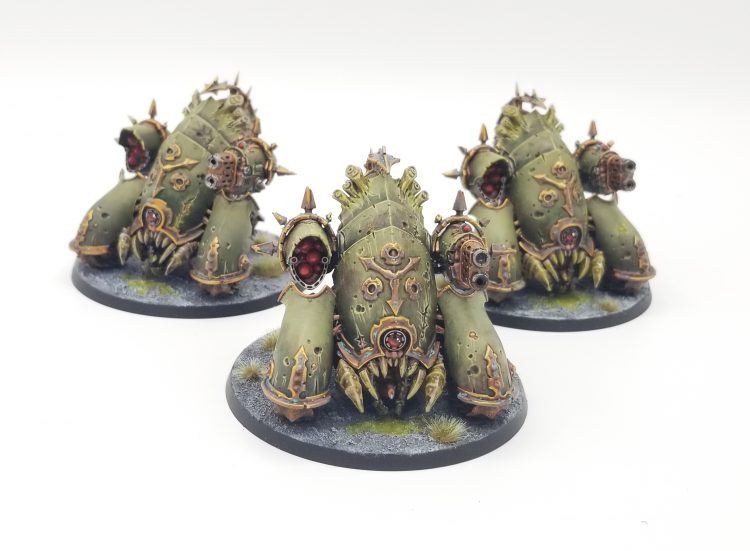
Myphitic Blight-Haulers
These cute little monsters come in units of 1-3 and while they aren’t as fast as they used to be they still offer mobile (10″ move), durable units (T9, 10W, 3+/5++ save) armed with a multi-melta and a missile launcher. They come with the Tank Hunters rule, which gives them +1 to wound against VEHICLE targets, and that’s kind of a must-have given multi-meltas are only S9 in 10th edition. Contagions also help with this a bit – the occasional T9 and T10 vehicle becomes much easier to wound with these guys, and the fact that they only cost 90 points per model basically makes them anti-vehicle alternatives of the Plague Drone, albeit easier to hide thanks to having a much lower profile.
Like Bloat-drones, Blight Haulers see play occasionally in successful competitive lists. Whether you want them in your army will primarily depend on what you’re up against – they do better in vehicle-heavy metas where their ranged firepower can be put to use, but won’t be nearly as effective if they have to handle lots of infantry. They’re also notably not so great against MONSTER targets, which aren’t mentioned in their Tank Hunters rule. This can make them feel really inconsistent, and while Bloat-drones feel priced to move at 90 points per model, these guys feel more appropriately-costed at that amount.
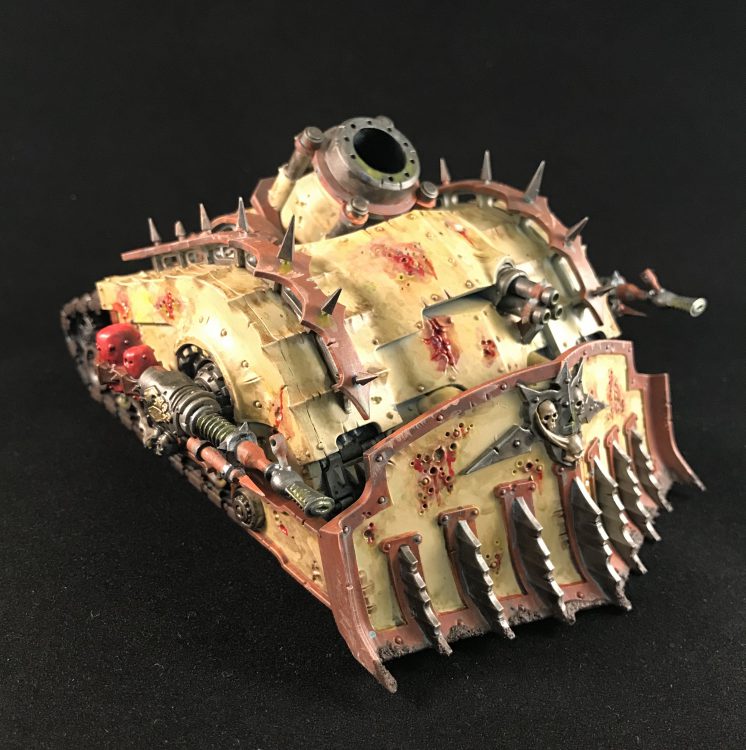
Plagueburst Crawler
Last on our list but certainly not least is the Plagueburst Crawler, which is still arguably the best vehicle in the Death Guard arsenal. The PBC offers a mobile (10″ move, an upgrade from 9th edition), tough body (T10, 2+/5++ save, 12W) with OC 4 and comes with a Plagueburst Mortar, your choice of rothail volley gun/heavy slugger, and either two entropy cannons or two plaguespitters.
The Plagueburst Crawler used to be a must-take in Death Guard lists, but with changes to Indirect Fire and points hikes, the days of needing to take three are over. You can still do very well with 2-3 in your list however, and even hitting on a 4+, being able to reliably threaten or even kill units out of line of sight is massive in 10th edition, giving the army a much-needed alpha strike potential it otherwise lacks. Being able to kill units of cultists or intercessors before they can make an objective sticky when you have the first turn is massive, and just generally having 3D6 2-damage mortar shots per turn forces opponents to play around your capabilities in the same fashion as whirlwinds, exorcists, and nightspinners. On top of that, the PBC comes with two other important guns – the Entropy Cannons give the army some much-needed anti-vehicle firepower while the plaguespitters make it a nasty close-range fighter to push to the middle of the table. I typically take entropy cannons on all three of mine for consistency and because I tend to take more spitters in my plague marine squads, but there’s also a good case to be made for taking two with entorpy and one with spitters to act as your forward tank.
Thanks to the changes to Indirect Fire, there’s more incentive than ever to play aggressively with your PBCs. While they’re great for holding a backfield objective, they’re also durable enough to press forward and bully units with their OC 4 chassis, and hitting things you can see with Mortars is just fine. They’re also much more effective at Tank Shocking enemy targets now, throwing out 12 dice instead of 6, and so charging with them isn’t too shabby, either – especially if your target has four or fewer wounds remaining.
Even with the changes to indirect, PBCs love Mortarion, who gives them both the ability to ignore the -1 to their hit rolls when low on wounds or when they’re within Engagement Range of an enemy unit, and who also lets them re-roll wound rolls of 1 to get more consistency on their shooting. Again, the key here is to press forward while shooting,
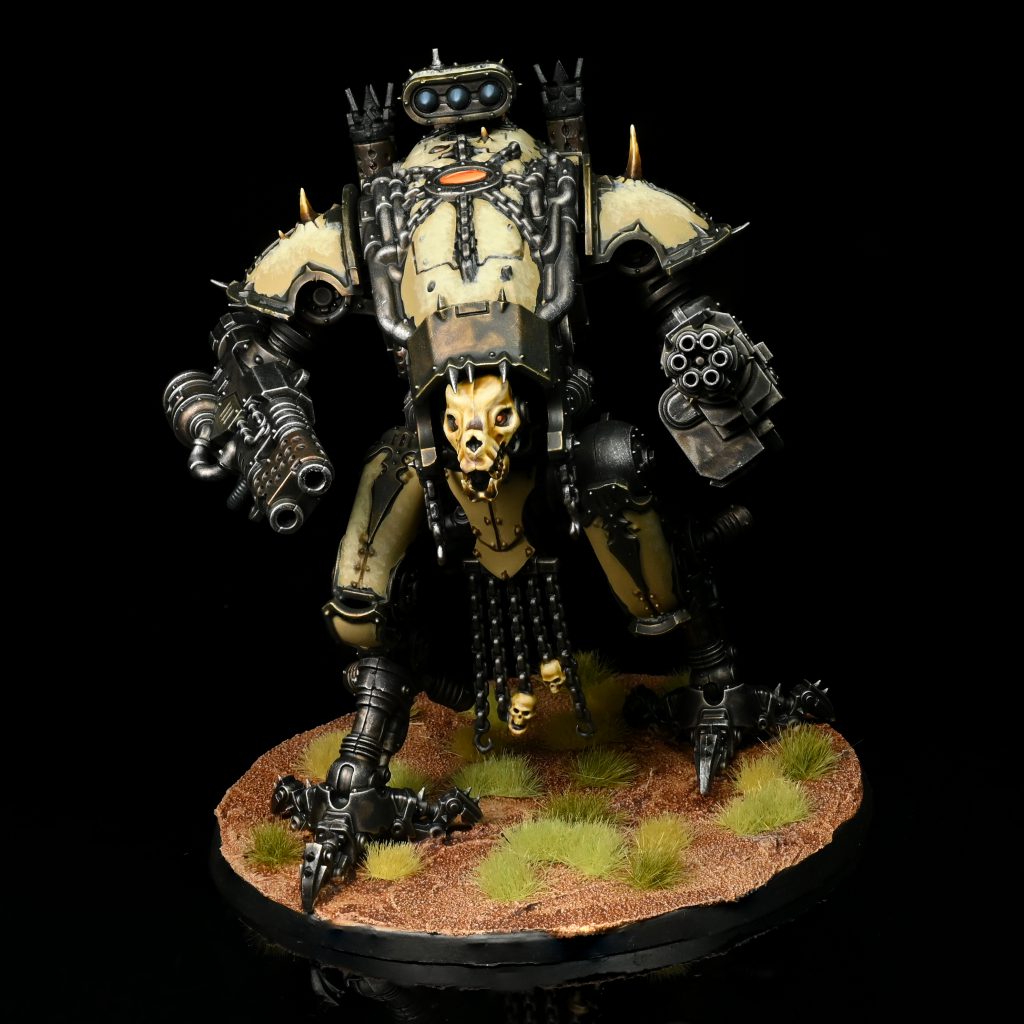
Allied Vehicles
Finally it’s worth noting that Death Guard armies can make use of allied Chaos Knights units to bolster their ranks. While these aren’t necessary to building a successful competitive list, there is one option here that stands out: The War Dog Brigand. The Brigand clocks in at 160 points (pretty reasonable) and gives you a reasonably tough vehicle with 12″ movement and OC 8, which is staggeringly high compared to other vehicles in its weight class.
Where the Brigand really shines is that it comes with a two-shot Daemonbreath Spear and an Avenger Chaincannon, and the latter pairs with its Brigand ability, which gives it +1 AP when attacking the closest eligible enemy unit with ranged attacks. While the Brigand doesn’t project its own Contagion aura, it can make use of the contagion effects from allied units (as they’re a debuff on the target, not something only DEATH GUARD units can use). That means if you’re shooting the closest target, and that unit is in contagion range with Rattlejoint Ague (-1 to saves), you’re effectively throwing out AP-5 melta shots and 12 AP-3 avenger chaincannon shots, plus AP-2 Havoc launcher shots with Blast. That’s extremely nasty and great for punishing heavy infantry trying to claim objectives in the middle of the table.
Brigands have shown up in more than a few successful competitive lists, either as one-ofs or three-ofs, where they can combine good speed and firepower with their high OC to act as strong mid-table fire support for plague marines. If you’re taking three of them it’s probably in place of Mortarion, who does little to help them.
With the point hikes Brigands have received over the last year or so, some lists have started bringing Karnivores instead – these are comparatively cheaper and very fast, able to act as solid melee threats and amazing objective holders who can distract an opponent from your other vehicles… or punish them for focusing on them too much.
Have any questions or feedback? Drop us a note in the comments below or email us at contact@goonhammer.com.
